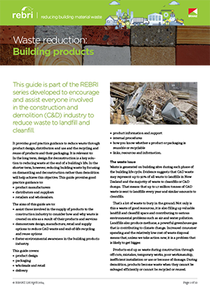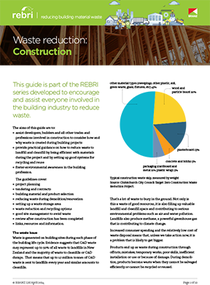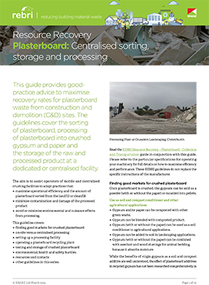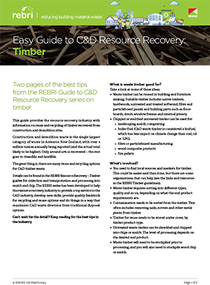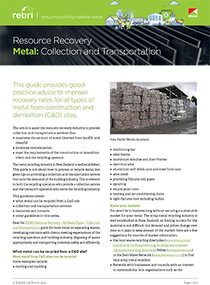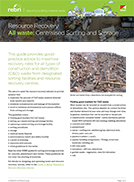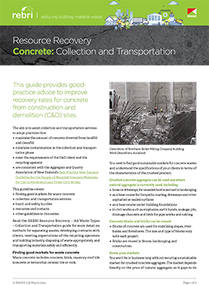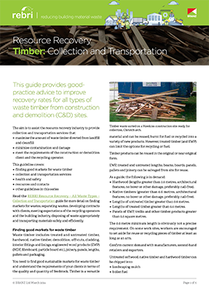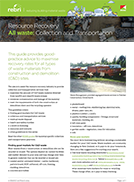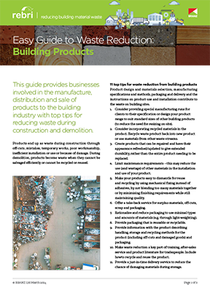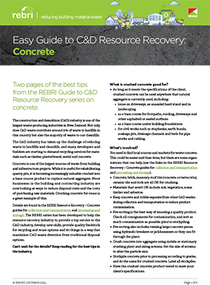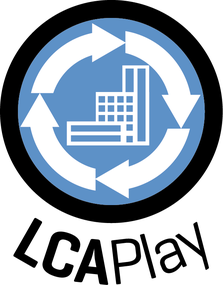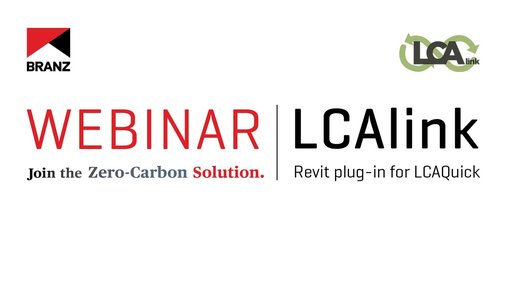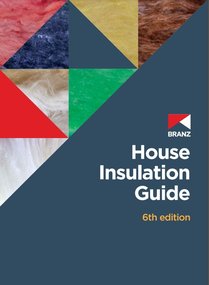Plumbing and Drainage Guide 3rd edition (PDF)
This guide explains the general principles of the plumbing codes and standards for sanitary plumbing in New Zealand and Australia. Issues such as backflow prevention, protection from scalding and explosion by hot water installations and the use of air admittance valves are explained in clear and simple text. This edition was updated and released in April 2024 to reflect recent changes to AS/NZ3500 series and amendments to New Zealand Building Code clauses G12 and G13.
REBRI Waste reduction: Building products (PDF)
This guide is part of the REBRI series developed to encourage and assist everyone involved in the construction and demolition (C&D) industry to reduce waste to landfill and cleanfill.
It provides good practice guidance to reduce waste through product design, distribution and use and the recycling and reuse of products and their packaging. In the long term, design for deconstruction is a key solution to reducing waste at the end of a building’s life. In the shorter term, however, reducing building waste by focusing on dismantling and deconstruction rather than demolition will help achieve this objective.
This guide provides good practice guidance to:
- product manufacturers
- distributors and suppliers
- retailers and wholesalers.
The aims of this guide are to:
- assist those involved in the supply of products to the construction industry to consider how and why waste is created on site as a result of their products and services
- demonstrate design, manufacture, retail and supply options to reduce C&D waste and end-of-life recycling and reuse options
- foster environmental awareness in the building products industry.
This guide covers:
- product design
- packaging
- wholesale and retail
- delivery
- product information and support
- internal procedures
- how you know whether a product or packaging is reusable or recyclable
- links, resources and information.
REBRI Waste reduction: Construction (PDF)
This guide is part of the REBRI series developed to encourage and assist everyone involved in the building industry to reduce waste.
The aims of this guide are to:
- assist developers, builders and all other trades and professions involved in construction to consider how and why waste is created during building projects
- provide practical guidance on how to reduce waste to landfill and cleanfill by being efficient with materials during the project and by setting up good systems for recycling and reuse
- foster environmental awareness in the building profession.
The guidelines cover:
- project planning
- tendering and contracts
- building material and product selection
- reducing waste during demolition/renovation
- setting up a waste storage area
- waste reduction and recycling options
- good site management to avoid waste
- review after construction has been completed
- links, resources and information.
REBRI Resource Recovery Plasterboard: Centralised sorting, storage and processing (PDF)
This guide provides good practice advice to maximise recovery rates for plasterboard waste from construction and demolition (C&D) sites. The guidelines cover the sorting of plasterboard, processing of plasterboard into crushed gypsum and paper and the storage of the raw and processed product at a dedicated or centralised facility.
The aim is to assist operators of mobile and centralised crushing facilities to adopt practices that:
- maximise operational efficiency and the amount of plasterboard sorted from the landfill or cleanfill
- minimise contamination and damage of the processed product
- avoid or minimise environmental and nuisance effects from processing.
This guideline covers:
- finding good markets for crushed plasterboard
- on-site versus centralised processing
- setting up a processing facility
- operating a plasterboard recycling plant
- testing and storage of crushed plasterboard
- environmental, health and safety hurdles
- resources and contacts
- other guidelines in this series.
REBRI Easy Guide to C&D Resource Recovery: Timber (PDF)
Two pages of the best tips from the REBRI Guide to C&D Resource Recovery series on timber.
Features:
- What is waste timber good for?
- What’s involved?
- Some things to think about
- Examples from those out there doing it
REBRI Resource Recovery Metal: Collection and Transportation (PDF)
This guide provides good practice advice to improve recovery rates for all types of metal from construction and demolition (C&D) sites.
The aim is to assist the resource recovery industry to provide collection and transportation services that:
- maximise the amount of metal diverted from landfill and cleanfill
- minimise contamination
- meet the requirements of the construction or demolition client and the recycling operator
The metal recycling industry in New Zealand is well established. This guide is not about how to process or recycle metal, but gives tips on providing a collection and transportation service that suits the demands of the building industry. This is relevant to both the recycling operators who provide a collection service and the transport operators who serve the recycling industry.
This guideline covers:
- what metal can be recycled from a C&D site
- collection and transportation services
- resources and contacts
- other guidelines in this series.
REBRI Resource Recovery Plasterboard: Collection and Transportation (PDF)
This guide provides good practice advice to improve recovery rates for waste plasterboard from construction and demolition (C&D) sites.
The aim is to assist collection and transportation services to C&D sites to:
- maximise the amount of plasterboard diverted from the landfill and cleanfill
- minimise contamination and damage
- meet the requirements of the construction or demolition client and the recycling operator.
This guideline covers:
- finding good markets for recycled plasterboard
- collection and transportation services
- health and safety hurdles
- resources and contacts
- other guidelines in this series.
REBRI Resource Recovery All waste: Centralised Sorting and Storage (PDF)
This guide provides good practice advice to maximise recovery rates for all types of construction and demolition (C&D) waste from designated sorting facilities and resource recovery centres.
The aim is to assist the resource recovery industry to provide systems that:
- maximise the amount of C&D waste material diverted from landfill and cleanfill
- minimise contamination and damage of the material
- avoid or minimise environmental and nuisance effects from sorting and storage.
This guideline covers:
- finding good markets for C&D waste
- setting up a waste-sorting and storage facility
- operating a waste-sorting and storage facility
- sorting procedures
- storage
- residual waste disposal
- environmental, health and safety hurdles
- a word on licensing
- resources and contacts
- other guidelines in this series.
REBRI Resource Recovery Concrete: Collection and Transportation (PDF)
This guide provides good practice advice to maximise recovery rates for concrete from construction and demolition (C&D) projects by improving crushing, screening and stockpiling processes.
The aim is to assist the operators of crushing and screening systems to adopt practices that:
- maximise operational efficiency and the amount of concrete crushed and screened into chip product
- minimise contamination and maximise the quality of the chip product
- avoid or minimise environmental and nuisance effects from processing and storage.
This guideline covers:
- finding good markets for waste concrete
- collection and transportation services
- heath and safety hurdles
- resources and contacts
- other guidelines in this series.
REBRI Resource Recovery Timber: Collection and Transportation (PDF)
This guide provides good practice advice to improve recovery rates for all types of waste timber from construction and demolition (C&D) sites.
The aim is to assist the resource recovery industry to provide collection and transportation services that:
- maximise the amount of waste timber diverted from landfill and cleanfill
- minimise contamination and damage
- meet the requirements of the construction or demolition client and the recycling operator.
This guideline covers:
- finding good markets for waste timber
- collection and transportation services
- health and safety
- resources and contacts
- other guidelines in this series.
REBRI Resource Recovery All waste: Collection and Transportation (PDF)
This guide provides good practice advice to maximise recovery rates for all types of waste materials from construction and demolition (C&D) sites.
The aim is to assist the resource recovery industry to provide collection and transportation services that:
- maximise the amount of C&D waste material diverted from landfill and cleanfill waste stream
- minimise contamination and damage of the material
- meet the requirements of both the construction or demolition client and the recycling operator.
This guideline covers:
- finding good markets for C&D waste
- collection and transportation services
- residual waste disposal
- health and safety hurdles
- a word on licensing
- resources and contacts
- other guidelines in this series.
REBRI Easy Guide to Waste Reduction: Building Products (PDF)
This guide provides businesses involved in the manufacture, distribution and sale of products to the building industry with top tips for reducing waste during construction and demolition.
Features:
- 11 top tips for waste reduction from building products
- Benefits of reducing product waste
- The waste issue
REBRI Easy Guide to C&D Resource Recovery: Plasterboard (PDF)
Two pages of the best tips from the REBRI Guide to C&D Resource Recovery series on plasterboard.
Features:
- What is waste plasterboard good for?
- What’s involved?
- Some things to think about
- Examples from those out there doing it
REBRI Easy Guide to C&D Resource Recovery: Concrete (PDF)
Two pages of the best tips from the REBRI Guide to C&D Resource Recovery series on concrete.
Features:
- What is crushed concrete good for?
- What’s involved?
- Examples from those out there doing it
- Some things to think about
REBRI Resource Recovery Timber: Processing into Mulch and Chip (PDF)
This guide provides good practice advice to maximise recovery rates for waste timber from construction and demolition (C&D) projects by improving shredding and screening processes. The guidelines cover the processing of pre-sorted waste timber into chip or mulch product and the stockpiling of the processed products.
The aim is to assist the operators of shredding and screening systems to adopt practices that:
- maximise operational efficiency and the amount of waste timber processed
- minimise contamination or damage of the mulch or chip product
- minimise the inappropriate burning or processing of treated timber
- avoid or minimise environmental and nuisance effects from processing.
This guideline covers:
- finding good markets for waste timber
- on-site versus centralised processing
- setting up a processing facility or mobile operation
- operating a timber-processing plant
- storing chip and mulch products
- environmental, health and safety hurdles
- resources and contacts
- other guidelines in this series.
REBRI Easy Guide to Waste Reduction: Construction (PDF)
This guide provides builders, building owners and developers top tips for reducing waste during construction.
Features:
- 10 top tips for waste reduction during construction
- Benefits of reducing waste during construction
REBRI Easy Guide to C&D Resource Recovery: Metal (PDF)
Two pages of the best tips from the REBRI Guide to C&D Resource Recovery series on metal.
Features:
- What type of metals do you find in C&D waste?
- What’s involved?
- Some things to think about
- Examples from those out there doing it
LCAPlay V2.0 (February 2024)
Use LCAPlay to evaluate the potential greenhouse gas emissions (and other environmental impacts) of alternative building options.
Webinar: LCAlink - Revit plug-in for LCAQuick
BRANZ House Insulation Guide 6th edition V2.1 MAC (November 2023)
This XLXS [25MB] download of BRANZ House Insulation Guide 6th edition is for MAC users.
New Features:
- A helpful “Door” sheet for determining the R-value of doors (leaf and frame) based on the R-value and size of the door leaf and the material of the frame. This does not include sliding doors.
- A frame fraction estimator to the “Wall” sheet. This addition is experimental and still under development. Addtional option to note the source of the frame fraction value. That source may be for instance the frame & truss supplier, or it may have been estimated from the plans.
- Data entry summary at the top of each of the sheets. The completed sheet can be reproduced using this character string.
Other verion updates:
- Repaired an error with the “Roofs” sheet where the R-value included the effects of an R1.2 secondary insulation layer, even when that option wasn’t selected. It only applied to the case where the joist height was 290mm.
- Improved appearance of the “Roof edge” sheet.
The guide is now in two parts:
- The tables of construction R-values for common construction options for compliance under H1/AS1 and H1/VM1 5th edition
- The accompanying House Insulation Guide text [PDF] for guidance on insulation to meet or exceed H1 AS/1 and H1/VM1 5th edition.





